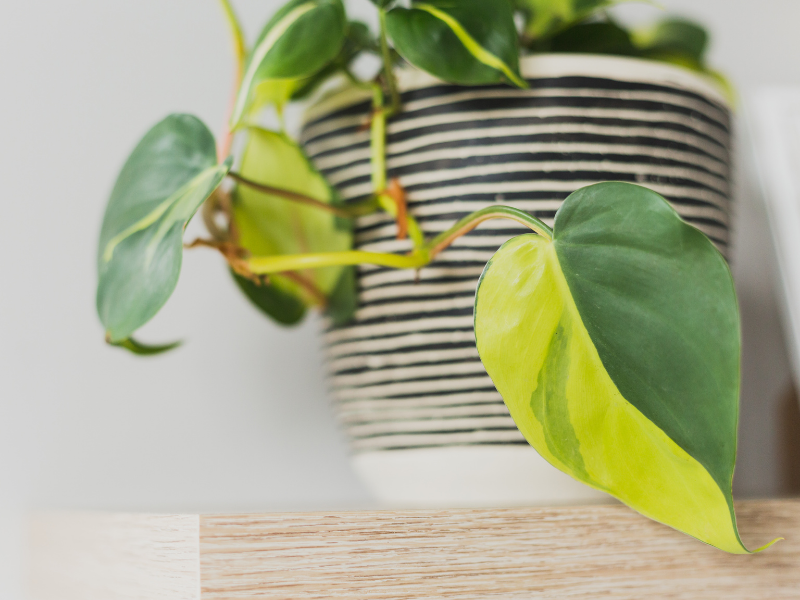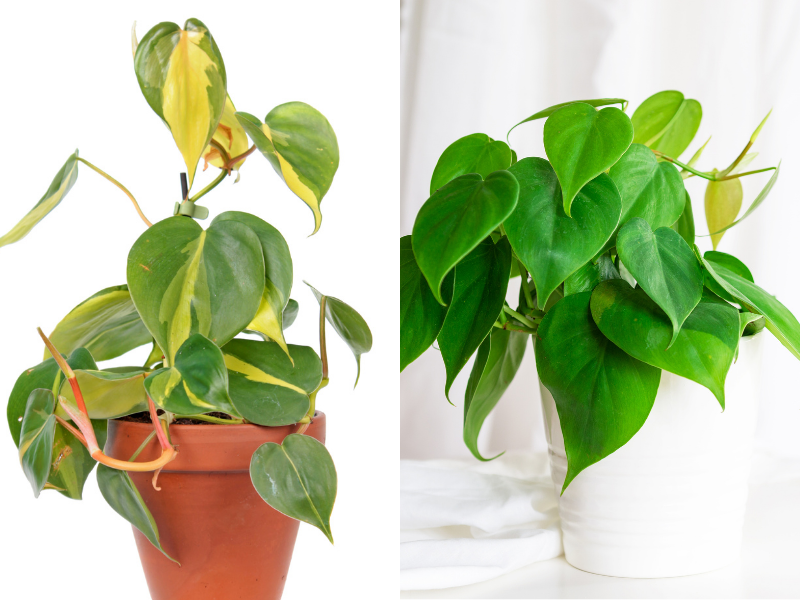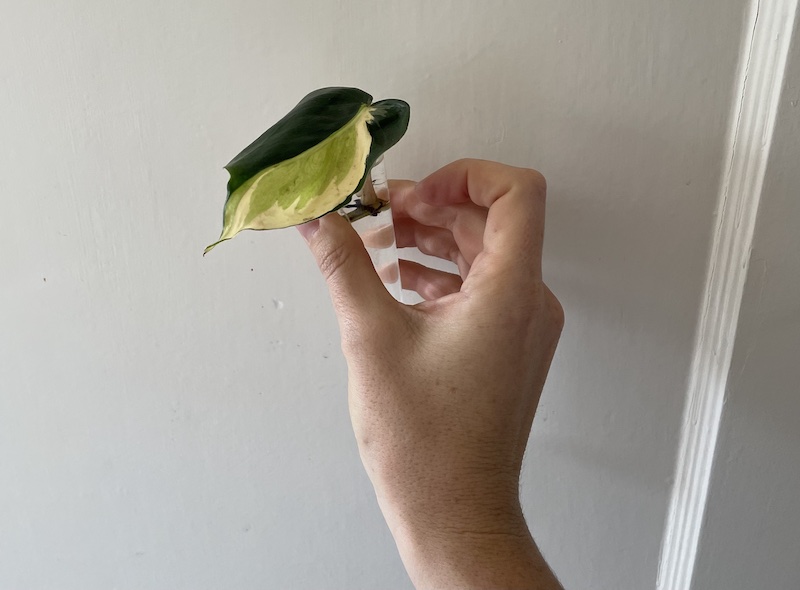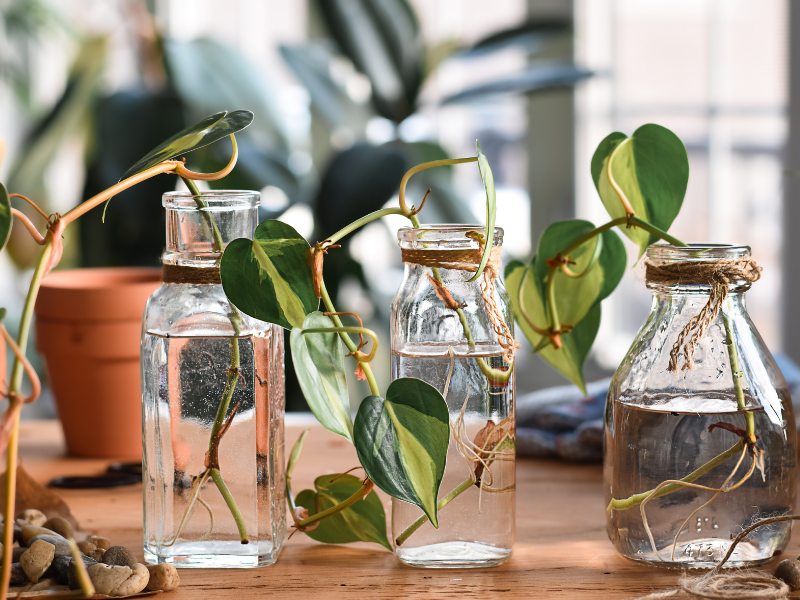This gorgeous plant adorns houses all over the world because of how adaptable it is– it can grow in both humid and relatively dry homes, as well as in warm and in slightly cold climates. As such, P. Brasil is one of the easiest tropical plants you could care for.
The Philodendron Brasil is not for you if you want a plant that always looks the same as when you purchased it. Each leaf has the potential to throw out different degrees of variegation, and that colorful twist is what makes P. Brasil so appealing!
In this detailed care guide, we’ll walk you through the proper practices to keep your Philodendron Hederaceum Brasil at its happiest! We’re also sharing trivia and FAQs about the origin and the popular sport cultivars of this plant!
Table of Contents
My Experience With Philodendron Brasil

My Philodendron Brasil is an extremely quick grower! I got it as a small, 4-inch plant that was barely tumbling out of its pot. This is it after about 8 months of growth!
Now, it’s cascading over its pot and looks really beautiful in its macrame holder. It does well with medium-low light in a far corner of my bathroom and still is growing quite quickly.
I also acquired a Philodendron Gabby cutting from a local plant swap friend — I’ll be updating this page in the future to update on how it roots and grows over time!
Where Can I Find Philodendron Brasil for Sale?

Philodendron Brasil is a very easy-to-find plant.
In fact, you can even find it on Amazon these days!
Philodendron Brasil Overview & Origins
Philodendron Brasil is one of the most popular houseplants in the world, but its commonness doesn’t take away from the classic beauty of this cascading tropical vine. Each heart-shaped leaf is punctuated by a fine line of neon green to yellow variegation in the middle.
According to this plant’s patent file, the variegation came about as a natural mutation of a Heartleaf Philodendron specimen from Holambra, Brazil. Later on, the mutated plant was cultivated and reproduced in Sebring, Florida to be made available to the masses.
Some say that Philodendron Brasil was named so because its variegation resembles the colors of the Brazilian flag, except that it’s spelled with an ‘s’ because that’s how “Brasil” is written in Portuguese.
Philodendron ‘Brasil’ is the patented name and the only official name of this plant from the Araceae family. This cultivar was never registered with the International Aroid Society, so it simply doesn’t have a botanical ID.
The variegation of the Philodendron Brasil is relatively unstable, potentially varying from leaf to leaf. So, you can enjoy an ever-changing display throughout the year!
Philodendron Brasil vs. Heartleaf Philodendron

Both Philodendron Brasil and Heartleaf Philodendron are naturally-occurring forms of the same species – Philodendron Hederaceum. While P. Brasil has yellow variegation, the Heartleaf Philodendron only has solid green leaves.
In 1991, Ruben Ernesto Acosta suddenly found yellow variegation among the leaves of a Heartleaf Philodendron plant grown in a controlled environment in Brazil. He then cultivated and patented the mutated specimen as Philodendron ‘Brasil’.
The US Patent he filed for Brasil wrongly labels its parent plant, the Heartleaf Philodendron, as Philodendron scandens oxycardium. That name is merely a synonym for the botanically-correct ID which is Philodendron hederaceum var. oxycardium. You may know it from its common name as the Sweetheart Plant.
Note that P. Hederaceum in itself is a highly variable species which has gone through many name changes in botanical history. The arguments date as far back as 180 years ago!
According to US laws, anyone who a) discovers a naturally-occurring variety of any species or b) “invents” a new cultivar can patent the plant and claim exclusive rights to reproduce and sell that plant.
The patent for P. Brasil was filed in the year 2000 and expired in 2020. This means the plant can now be legally reproduced and sold by anybody! This may be why, if you’ve noticed, many Brasil cultivars such as Rio, Gabby, Cream Splash, and Silver Stripe are making waves in the market in recent years.
4 Sport Cultivars of Philodendron Hederaceum ‘Brasil’
The variegation of the Philodendron Brasil can exhibit many reversions and natural variations (like a Philodendron Birkin). This may occur randomly because of the plant’s genetics, or it can be affected by environmental factors such as light intensity and temperature.
You may have heard of the many sport cultivars of P. Brasil hitting the market in recent years. Here are some of them:
[Note: “Sport” in horticulture simply means that a section of a plant spontaneously grew with different characteristics from the rest of the plant.]
1. Philodendron Rio
The Philodendron Rio is a sport of Brasil that originated from the 2-decade old greenhouse of Gabriella Plants. Also known as Gabriella Growers, this family-owned nursery in the USA has selected and reproduced unique cultivars from their own Hederaceum plants.
They have properly documented these plants since 2009 (and as of writing, they are awaiting approval for the patents they submitted). According to Gabriella Plants, the leaves of the Rio cultivar have shown a consistent pattern of variegation for over a decade in their care.
Aside from having a more stable variegation than the other sports, the Rio can be distinguished by its longer, sharper leaf shape. Typically, it has a silver color at the center, mixed with cream variegation against glossy green leaves.
Its first search appearance in Google Trends was in 2005, but it peaked in 2020.
2. Philodendron Gabby
Philodendron Gabby is another Brasil sport which Florida-based cultivator Gabriella Plants recently released to the public. P. Gabby is characterized by dominantly cream-colored leaves.
Despite first appearing on Google Trends only in 2019, the Gabby has quickly risen to fame among plant collectors. A single cutting is currently worth triple dollar digits!
A Brasil plant from any part of the world can randomly mutate to show similar characteristics as the Gabby. However, in order for a plant to be officially called Philodendron Gabby, it has to vegetatively originate from the parent plant within Gabriella Plants’ care.

If you want an authentic Gabby, ask for a copy of a certificate issued by Gabriella Plants when buying this plant from third party sellers!
According to Gabriella Plants, their Gabbys are maintaining (for at least a decade) heavily variegated leaves despite being grown next to Brasil plants under identical lighting!
However, they also warn that the variegation is not fully stable and can only be maintained under ideal growing conditions. The dominantly cream or white-colored leaves of the Gabby are extremely delicate, and can eventually shrink in size and growth speed.
3. Philodendron Silver Stripe
Variegation is a discoloration of plant leaves, either through natural or artificial causes. The Philodendron Silver Stripe is an example of a naturally-occurring mutation in P. Brasil.
The variegation pattern of the Silver Stripe usually starts with a neon green color in the midrib (or the central vein), followed by a slender strip of silver, and then flashes of cream or white contrasting the rest of the dark green leaf.
It is said that the variegation of the Silver Stripe is fairly stable. However, this plant can be difficult to differentiate from the Philodendron Cream Splash.
The first mention of the Philodendron Silver Stripe on Google Trends was in 2008, but it has recently peaked in 2021.
4. Philodendron Cream Splash
The Philodendron Cream Splash has unclear origins, but it first appeared on Google Trends in 2018. The variegation colors of Cream Splash vary widely as seen on photos shared online.
Supposedly, this Brasil sport has big splashes of cream and some light green as its variegation pattern against the dark green edges of the leaf.
The Cream Splash is often confused with the Silver Stripe. Some sources would even claim that these two varieties are one and the same.
Sometimes, “P. Cream Splash” is used as a label for heavily-variegated specimens which almost look like P. Gabby. However, the Cream Splash will never consistently produce the same level of variegation that authentic Gabby plants do!
Philodendron Brasil Care Guide
The care practices for the Philodendron Brasil are pretty straight-forward. It doesn’t require a lot of maintenance so it’s perfect for beginners or non-green thumbs!
The Brasil can tolerate a wide range of lighting and temperature conditions, along with all kinds of neglect. Just avoid extremes in terms of moisture or drought. Other than that, you can’t really go wrong with this plant.
You can decorate your home with P. Brasil in a hanging basket or as a bushy table-top plant. This plant is known to be a hardy fast grower. You’ll have that indoor jungle vibe in no time if that’s what you’re going for!
Philodendron Brasil Light Needs
Philodendron Brasil thrives in medium light to bright indirect light. The beautiful golden variegation is probably part of the reason that you got this plant in the first place. Keep your plant near sunny windows if you want to keep it that way.
Some might say that the variegation of Brasil is solely affected by the plant’s genetics and not by environmental factors such as light. That is simply not true! There are many papers that study the effects of varying light intensities on variegated plants.
To demonstrate, here is a photo of a Philodendron Brasil developing more variegation when it was exposed to more Sun, as shared on Reddit!
It is important to note that exposing your Brasil to direct sunlight for multiple hours in a day can cause its leaves to turn brown or fade. In that case, pull it back away from the window or put up some curtains to filter out too much light.
Philodendron Brasil Watering Needs
Like most climbing epiphytes, the Philodendron Brasil has developed a tolerance for short periods of drought. Let the top 1-3 inches of soil dry out before giving your Brasil a deep watering.
How much water your Brasil needs is determined by 1) its placement in your home, 2) its soil type, 3) its potting material, and the 4) ambient humidity and temperature in your area.
Plants in brighter light, lower humidity, warmer temperatures, more gritty soil mix, and porous planters (such as terracotta or unglazed ceramic) will require an increased watering schedule. Usually, your Brasil will have droopy leaves if it’s thirsty.
Before giving your plant a drink, check for moisture by sticking your finger into the pot. When the top inch of soil feels dry to the touch, generously pour enough water over your plant until excess water flows out of the drainage hole.
Philodendron Brasil Soil Needs
When it comes to the soil of the Philodendron Brasil, good drainage and aeration are a must. Give your Brasil a growing medium with a lot of chunky, lightweight components to avoid root rot!
Philodendron plants mostly use their aerial roots to absorb moisture from the trees that they climb in their habitat. Their roots are not used to being buried in compact, soggy soil.
When preparing your potting mix, use materials such as orchid bark, cedar mulch, perlite, pumice, vermiculite, and horticultural coal for aeration. You can also add in some cocopeat or finely-cut sphagnum moss for water retention, and some vermicast for nutrients.
If you need an aroid soil mix recipe to help you out, we’ve got one for you! Of course, you can hydroponically grow your Philodendron Brasil in LECA. LECA is an excellent way to deter common issues such as fungus gnats and root rot.
Philodendron Brasil Temperature & Humidity Needs
Your Philodendron Brasil will grow well in temperatures between 60-90°F (16-32°C). It will also do fine in basic household humidity levels, but keeping your Brasil in high humidity will encourage larger leaves and a bushier look!
According to some owners of this plant we’ve come across, the Brasil can handle dry environments. However, if you notice any browning leaf edges or if you want your Brasil to grow more lush, you can purchase a humidifier for your plant.
Other inexpensive ways to increase humidity in your plant’s immediate area are: putting the pot above a flat tray of pebbles filled with water, keeping bowls of water to evaporate nearby, or grouping your plants closely together.
The Philodendron Brasil is not particularly fussy in terms of temperature, but make sure you avoid sudden swings between extreme cold and extreme heat. As a tropical plant, the Brasil might go dormant or even wilt in temperatures below 50°F.
Philodendron Brasil Fertilization Needs
The Philodendron Brasil doesn’t require much fertilizer to grow, but it can benefit from a monthly application of a well-rounded plant food in diluted concentrations. For best results, feed your Brasil more frequently during its growing season.
Generally, it’s not advisable to fertilize your Brasil in the winter months because it doesn’t get as much sun exposure to photosynthesize and grow. Also, it’s best to fertilize your plant only when there’s evidence of new growth.
Typically, synthetic fertilizers can be in the form of soluble powder, liquid fertilizer foliar spray, or slow-release coated pellets. Organic matter such as worm castings, chicken dung, or garden compost can be used as fertilizers too.
You can use any type of fertilizer as long as you follow the method and frequency of application as instructed on the product’s label.
Pruning Philodendron Brasil
Philodendron Brasil is a fast-growing plant that may require frequent trimming to keep its growth manageable indoors. Pruning also strengthens the stem and promotes lusher foliage.
Pluck off drying or dead leaves when you notice them because they can attract pests. They also use up the plant’s energy that could be better spent in producing new leaves.
Keep your Brasil looking full by pruning long, leggy vines. You can then propagate the cuttings you harvested, and later on replant them in the same pot to cover any bald spots near the base.
Propagating Philodendron Brasil

The Philodendron Brasil is one of the easiest plants to reproduce. There are 3 basic propagation methods you can choose from:
1. Soil propagation: Make a cutting with at least one leaf node (or else it will never grow new leaves). You can dip the wound in rooting or cinnamon powder if you have these on-hand. Then, plant the cutting into soil. Place your new plant in a bright shaded area and remember to keep the soil moist.
2. Water propagation: Any transparent container filled with water can be used to root a Brasil cutting, but remember to replace the water when it appears dirty. Keep the nodes submerged, but the leaves should remain above water level. Once the roots are long enough, you may transfer your cutting in soil.
3. Propagating in Perlite or Moss: Stem cuttings tend to root faster in perlite or in sphagnum peat moss. Inside a plastic container, bury the nodes of your cutting in damp perlite or moss. It will develop roots in 1-3 weeks, but keeping it under a grow light can speed up the process!
Repotting Philodendron Brasil
The Philodendron Brasil has thick, white roots that grow quickly. You may need to repot your plant once a year, preferably in the spring or summer months to allow the roots to recover more easily.
If the soil is drying fast despite frequent watering, or if roots are sticking out from the bottom of the pot, that means your plant is root-bound. In that case, it’s time to pot up!
When repotting, choose a bigger pot with at least one drainage hole. Fill the pot with new soil to replenish the nutrients. Maintain a bright and warm environment for your newly-transplanted Brasil. Don’t apply fertilizers or any treatments until your plant is stable!
Philodendron Brasil FAQ
Keep reading if you want to know more about the Philodendron Brasil’s growth behavior, size potential and growth rate, and some common problems you might be having about this plant!
Does Philodendron Brasil climb or trail?
The stem of the Philodendron Brasil is not sturdy. Instead, it uses its long aerial roots to attach itself onto a vertical structure for support. Indoors, the Brasil is a climbing plant that will latch onto walls or shelves for upward growth!
In their natural habitat, Philodendrons are hemi-epiphytic. This means that they initially crawl along the forest floor, then eventually climb trees to reach for more light.
If you’re going for an indoor jungle display, you can allow your Brasil to climb up your walls or staircases. The Brasil doesn’t mind trailing down as well! However, note that Philodendron leaves will eventually come out smaller as the vines grow longer without anything to latch onto.
Either way, P. Brasil is known to be a prolific grower!
How do you make a Philodendron Brasil leaves bigger?
If you want your Philodendron Brasil to have bigger leaves, train your plant to climb up a moss pole, a trellis, a bamboo stick, or a cedar plank for support. More light also gives your Brasil the energy to grow bigger leaves!
The only time that Brasil will produce significantly bigger leaves is when its aerial roots have latched onto a sturdy structure. This is the plant’s way of protecting itself from falling over and snapping off.
Hemp twines, twist ties, floral wires, or soft yarn are some materials you can use to initially secure the stem against the structure of your choice. Don’t forget to moisten the pole or the plank to help the roots cling faster!
How long does Philodendron Brasil take to grow?
Many owners of this plant say that the Philodendron Brasil is a fast-grower that can quickly outgrow its pot within a matter of months. As such, regular pruning is required to keep a mature plant from taking over your home!
In the rainforests of South America and Central America, Philodendron Hederaceum can climb trees up to several feet tall and produce 19-inch long leaves. As seen on Facebook, here are some Brasil leaves growing larger than a human’s hand!
As indoor plants, Philodendron Brasils are way smaller. They are suitable for growing in kitchens, living rooms, or bathrooms with access to bright light. P. Brasil has an average height of 3 feet, but it can grow much taller than that if you allow it to climb upwards!
Exposing your Brasil to more light, watering and fertilizing it more frequently, and providing it with higher humidity can make it grow faster.
Why is my Philodendron Brasil turning brown?
Brown or yellow leaves on a Philodendron Brasil can point to many issues. Common causes include inconsistent watering, too much sunlight, low light, low humidity, overfertilizing, cold stress, or fungal diseases.
To pinpoint the exact cause for your plant’s browning foliage, the best way is to trace back your steps and recall whether you recently changed anything in your usual care practices. Of course, the problem might also be caused by changes in the weather.
If you still can’t find the culprit, you can use devices such as a soil moisture meter to verify if you are watering correctly, a pH test to gauge your soil’s acidity (affected by fertilizer use), a hygrometer to measure humidity, and a thermometer to check the room temperature.
Is Brasil a Pothos or Philodendron?
Brasil belongs to the Philodendron genus, but it is often wrongly called “Brazil Pothos” because it has similar vining tendencies and a heart-shaped look commonly found in pothos leaves.
Interestingly, none of the plants we know to be “Pothos” are botanically classified under the Pothos genus. The famous Golden Pothos, Neon Pothos, and Jade Pothos to name a few are actually members of the Epipremnum Aureum genus.
In fact, even the Philodendron Micans (which is a natural variation of Philodendron Hederaceum like Brasil is) often gets mistaken for a pothos. Many other small-leaved Philodendrons, along with some Epipremnums and Scindapsus plants, are often sold as a hanging plant with a “Pothos” tag.
In another article, we made it easy for you to understand the differences among these plants!

Eliza is a writer and a plant hobbyist from the tropical country of the Philippines. She views gardening as an art, but she has made it her mission to learn the scientific aspect of anything that grows on Earth.
